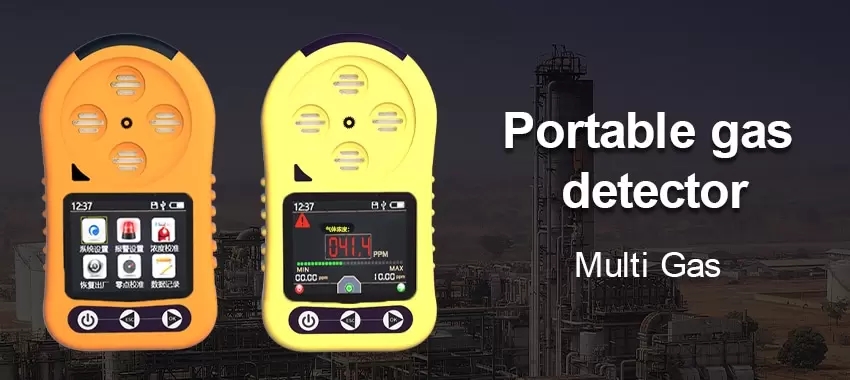Multi Gas Detector
In order to effectively monitor air quality and ensure the safety of communities, multi-gas detector have become an indispensable tool. These multi-gas detector advanced offer real-time, accurate measurements of multiple gases, enabling us to identify potential threats, respond promptly to emergencies, and implement effective mitigation strategies.

In this article, we will explore the significance of multi gas detector in environmental monitoring, their key features, applications, and the benefits they offer.
Importance of Environmental Monitoring:
Maintaining a healthy environment is essential for the well-being of both humans and ecosystems. Effective environmental monitoring allows us to:

1.1 Assess Air Quality: Monitoring various gases provides insights into air pollution levels, including harmful pollutants such as carbon monoxide (CO), sulfur dioxide (SO2), nitrogen oxides (NOx), volatile organic compounds (VOCs), and particulate matter (PM). This information helps identify pollutant sources and evaluate compliance with air quality standards.
1.2 Ensure Workplace Safety: Industries that handle hazardous materials or operate in confined spaces need to monitor gas concentrations to ensure worker safety. Multi-gas detectors play a vital role in preventing workplace accidents, such as gas leaks, by providing early warnings and triggering alarms when gas levels exceed permissible limits.
1.3 Respond to Emergencies: During emergencies, such as fires, chemical spills, or natural disasters, multi-gas detectors aid in rapid response and decision-making. They enable emergency responders to assess the situation, identify hazardous gases, and take appropriate measures to protect lives and mitigate risks.
1.4 Evaluate Environmental Impact: Monitoring gases emitted from industrial facilities, transportation systems, and energy production helps assess their environmental impact. It allows policymakers and industry stakeholders to develop targeted strategies for reducing emissions, improving air quality, and mitigating climate change.
Key Features of Multi-Gas Detectors:
Modern multi gas detector come equipped with several key features that enhance their utility and effectiveness in environmental monitoring:

2.1 Simultaneous Gas Detection: Multi gas detectors can detect and measure multiple gases simultaneously, providing real-time data on various pollutants. This feature allows for a comprehensive assessment of air quality and identification of potential hazards.
2.2 Sensor Technologies: Advanced sensor technologies, such as electrochemical, infrared, photoionization, and catalytic bead sensors, are incorporated into multi-gas detectors. Each sensor is designed to detect specific gases accurately, ensuring high sensitivity and reliability.
2.3 Data Logging and Connectivity: Many multi-gas detectors have built-in data logging capabilities, allowing for the storage and analysis of measurement data. Additionally, wireless connectivity options facilitate real-time data transmission, remote monitoring, and integration with environmental management systems.
2.4 Audible and Visual Alarms: Multi-gas detectors are equipped with audible and visual alarms that activate when gas concentrations exceed preset thresholds. These alarms help alert users to potentially dangerous situations, allowing for immediate action to protect lives and property.
2.5 Ruggedness and Portability: Environmental monitoring often requires working in challenging conditions. Multi-gas detectors are designed to be rugged and portable, with features such as water and dust resistance, shock resistance, and long battery life. This ensures their reliability and usability in diverse environments.
Applications of Multi-Gas Detectors in Environmental Monitoring
Multi-gas detectors find applications in various environmental monitoring scenarios, including but not limited to:

3.1 Industrial Settings: Industries that handle hazardous materials, such as chemical plants, refineries, and manufacturing facilities, utilize multi-gas detectors to ensure worker safety and compliance with occupational health regulations. These detectors monitor gas concentrations in real-time, enabling early detection of leaks or abnormal conditions.
3.2 Indoor Air Quality: Multi-gas detectors are used to assess indoor air quality in residential, commercial, and public buildings. They help identify potential sources of indoor pollution, such as faulty heating systems, mold growth, or volatile organic compounds released from furnishings or cleaning products.
3.3 Construction Sites: Construction sites often generate dust, emissions from machinery, and hazardous gases. Multi-gas detectors are employed to monitor workers’ exposure to gases like carbon monoxide, nitrogen dioxide, and ozone, ensuring compliance with safety standards and minimizing health risks.
3.4 Environmental Impact Assessment: Multi-gas detectors play a crucial role in assessing the environmental impact of infrastructure projects, industrial expansions, or waste management facilities. By monitoring emissions and ambient air quality, they help mitigate potential environmental risks and ensure compliance with regulatory requirements.
3.5 Emergency Response: During emergencies, such as chemical spills, fires, or natural disasters, multi-gas detectors aid emergency responders in evaluating hazards and implementing appropriate safety measures. They provide vital information on gas concentrations, enabling responders to evacuate